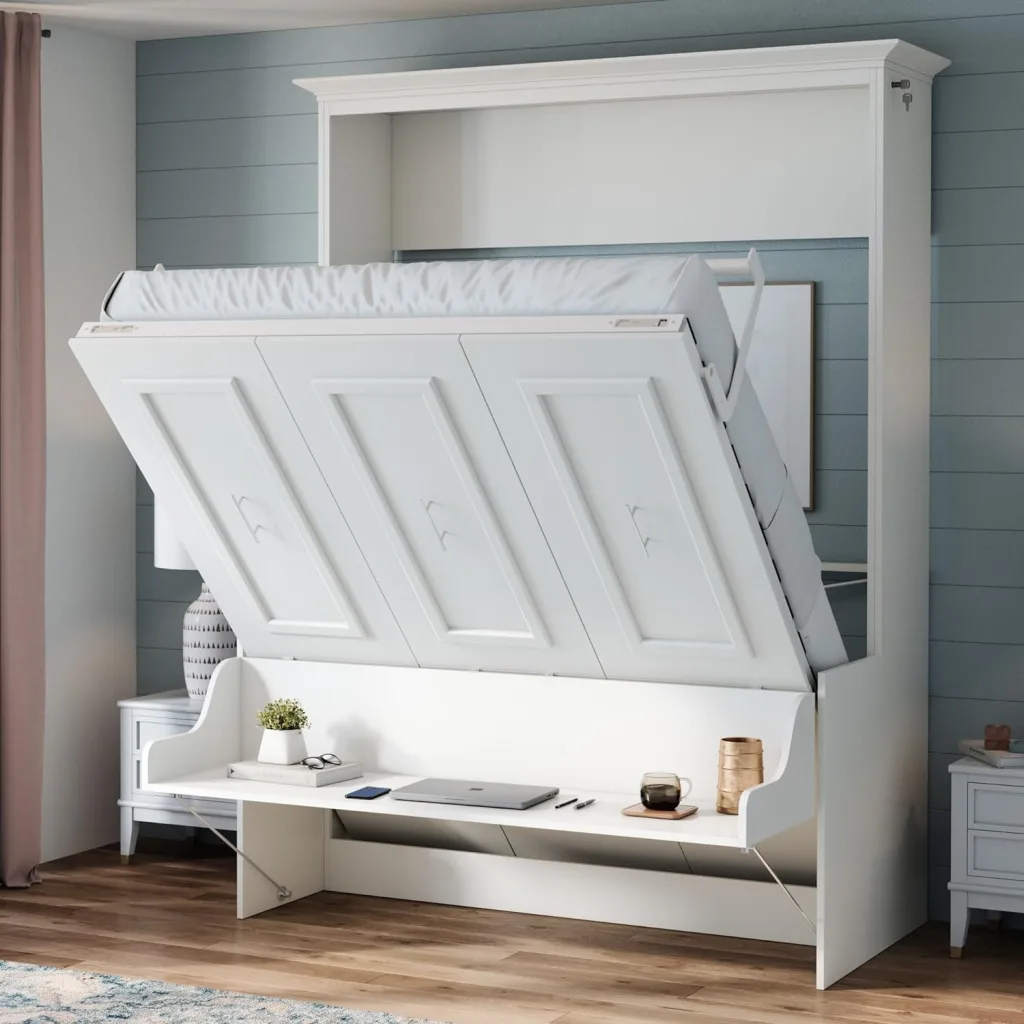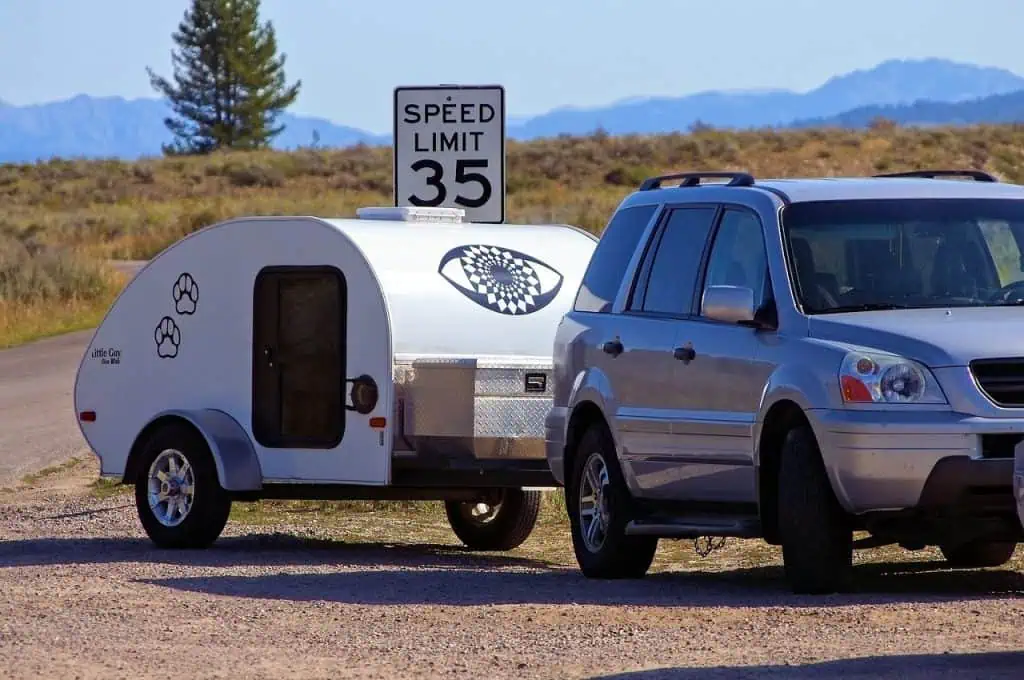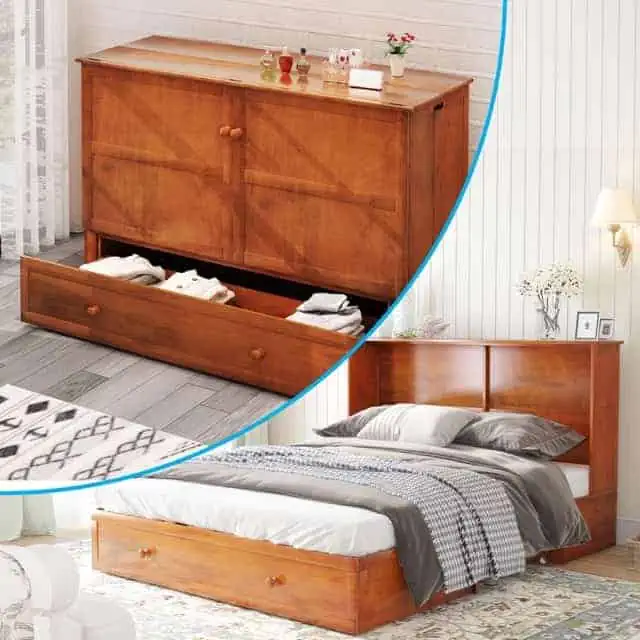How much does a tiny house on wheels typically weigh and why does it matter?
If you don’t know the weight of your tiny home it could cost you money and limit your adventures!

The weight of your tiny house can significantly impact your mobility, gas mileage, towing capacity, and overall living experience.
In this article, we’ll cover key factors that affect tiny house weight, explore average weight ranges, discuss legal weight limits, and provide strategies for keeping your tiny home lightweight and road-ready.
Get ready to learn everything you need to know about tiny house weight limits as you join the tiny house movement.
- Most tiny houses on wheels weigh between 6,000 – 10,000 lbs.
- The dry weight of a tiny house is the weight of the tiny house without any water, propane, or personal belongings.
- Total weight is the dry weights plus water, propane, and personal belongings.
- A lighter tiny house can be pulled by a smaller vehicles which saves on overall ownership costs.
- The weight of a tiny house can impact the roads it can travel on, where it can be parked and stored, and the ability to maneuver certain terrains.
- Lighter tiny homes have positive environmental impacts.
Disclosure: This post may contain affiliate links, meaning I can earn commissions. If you decide to purchase through my links, it is at no cost to you.
What does the Average Tiny Houses Weigh?
Most tiny houses on wheels weigh between 6,000 – 10,000 lbs. This range includes the structure itself, along with all the built-in furniture, appliances, and personal belongings.
Larger homes can easily exceed 10,000 lbs.
Empty Tiny House Weight: A Starting Point
When considering the weight of a tiny house, it’s important to understand the concept of “dry weight” or “empty weight”.
Dry Weight: This refers to the weight of the tiny house without any water, propane, or personal belongings. The dry weight is a starting point for calculating the total weight of your tiny home.
The empty weight of a tiny house on wheels can vary greatly depending on its size, building materials, and construction methods.
On average, a 20-foot tiny house on wheels may have a dry weight between 4,000 and 7,000 pounds, while a 30-foot tiny house can range from 8,000 to 15,000 pounds.
Tiny Home Weight-related Terms to Know
| Term | Definition |
|---|---|
| Tiny House Dry Weight | The structure and trailer weight without people, water, propane, personal items, or moveable furniture. |
| Gross Vehicle Weight Rating (GVWR) | Also referred to as gross vehicle mass (GVM), is the maximum operating weight/mass of a vehicle as specified by the manufacturer, including the vehicle’s chassis, body, engine, engine fluids, fuel, accessories, driver, passengers and cargo but excluding that of any trailers. |
| Gross Combined Weight Rating (GCWR) | Refers to the total mass of a vehicle including all trailers. GCWR is used to specify weight limitations and restrictions. |
| Gross Axle Weight Rating (GAWR) | The maximum weight on any particular axle. It is determined by the manufacturer and considers the capacity of the axle, tires, and suspension system. This rating applies to each individual axle, so if a trailer has multiple axles, the capacity of each is combined to calculate the total capacity. |
| Gross Trailer Weight (GTW) | The maximum weight of a trailer, including its frame and any cargo it may be carrying. This weight is typically specified by the manufacturer and is used to determine safe towing limits. |
| Payload Weight Rating | Since a trailer is balanced (unevenly, by design) to transfer some of the weight onto the tow vehicle itself, you want to make sure you’re not putting too much weight on the tongue. If you have too much weight on the tongue but are still under the weight rating of the trailer and tow vehicle, it might just be a matter of shifting the weight distribution around. |
| Tongue Weight | Since a trailer is balanced (unevenly, by design) to transfer some of the weight onto the tow vehicle itself, you want to make sure you’re not putting too much weight on the tongue. If you have too much weight on the tongue, but are still under the weight rating of the trailer and tow vehicle, it might just be a matter of shifting the weight distribution around. |
Typical Total Weight Range for Tiny Homes
The weight of a tiny house on wheels can vary significantly depending on its size, materials, and features.
Most tiny houses fall within the range of 6,000 to 10,000 pounds. This is just an average as tiny homes differ in length.
- Smaller tiny homes around 16 – 20 feet in length usually weigh between 6,000 and 7,000 pounds.
- Larger tiny homes that are 24 feet or longer can surpass 10,000 pounds.

These more spacious designs often include additional features and amenities that contribute to the increased weight, such as
- full-size appliances
- larger bathrooms
- more storage space

Towing Considerations for Tiny Houses
You have to understand the weight of your tiny house. Most tiny homes can be towed by a full-size pickup truck with an adequate towing capacity.
Consult your vehicle’s towing capacity and ensure that it can safely handle the weight of your tiny home, including any additional cargo.

A properly equipped half-ton truck can typically tow between 5,000 to 8,000 pounds, making it suitable for many 16-foot to 20-foot tiny homes.
However, for heavier tiny houses exceeding 10,000 pounds, a more powerful vehicle, such as a three-quarter to one-ton pickup truck, may be necessary.
Tiny Home Communities in the USA By State [Bookmark this!]
Understanding Maximum Gross Vehicle Weight Ratings (GVWR)
When building or purchasing a tiny house on wheels, you have to understand the concept of Maximum Gross Vehicle Weight Ratings
In the United States, three important GVWR limitations are 6,000, 8,500, & 26,000 pounds [lbs]
Wikipedia.org
(2,722, 3,856, & 11,793 kg).
A finished tiny house weighs, on average, 500 to 550 lbs per linear foot of trailer length.
Laws vary from state to state, but typically vehicles over 10,000 lbs are required to stop at weight stations. Sometimes large passenger or non-commercial vehicles such as RVs are exempt from this.
Exceeding the GVWR can result in fines, legal issues, and, most importantly, safety concerns.
An overloaded trailer:
- is more difficult to control
- puts excessive strain on the towing vehicle
- increases the risk of accidents
How to Determine the Weight of a Tiny Home?
Tiny Houses are surprisingly easy to weigh once they are mobile. All you have to do is tow your house to a publicly certified CAT truck scale and spend about $20.
Follow the instructions below:
- Make sure to disconnect your weight distribution system if you have one.
- Drive onto the scale making sure:
- The front axle of your truck (steer axle) is on the very front platform.
- The rear axle (drive axle) is on the following platform.
- The wheels of your house (trailer axles) are on the next platform.
- See other platform layouts.
- Hit the button on the intercom alerting the attendant that you are ready to weigh.
(** Some scales allow you to detach the tiny house on the scale without having to drive off so inquire on this option to save time.**) - The attendant will let you know when it is okay to get off the scale.
- Drive off and pick up your weight certificate at the register.
- The cost is $14+.
- Let the attendant know you will need a re-weigh if you have to detach the tiny house. (usually another $4+)
- Detach your Tiny House.
- Do the steps 2-5 with the TRUCK ONLY (first two platforms).
Examples of CAT scale Certificates
With the Tiny House Without the Tiny House
(Note: This example weighed the truck with an additional person once the tiny house was detached.)
To calculate the weight of your tiny house, use this calculator:
Results:
Gross Combined Weight (GCW): 0 lbs
Truck Weight (Hitched): 0 lbs
Truck Weight (Unhitched): 0 lbs
Tiny House Weight: 0 lbs
Pin Weight: 0 lbs
Pin Weight Percentage: 0%
Tiny House Weight Considerations: Factors Affecting Overall Weight
When it comes to tiny houses on wheels, weight is a factor that cannot be overlooked because directly impacts its mobility, safety, and compliance with road regulations.
Every pound matters!
Trailer Weight and Tiny Houses
When calculating the weight of your tiny home, don’t forget to account for the trailer itself.
You can usually find the trailer’s weight on the manufacturer’s website or in its specifications.

Here are some typical trailer weights:
| Trailer Length | Trailer Weight (Apx) |
|---|---|
| 16 ft. | 2,300 lbs. |
| 20 ft. | 2,700 lbs. |
| 24 ft. | 3,300 lbs. |
| 30 ft. | 3,900 lbs. |
| 34 ft. | 4,400 lbs. |
| 36 ft. | 4,700 lbs. |
| 40 ft. | 5,300 lbs. |
| 42 ft. | 5,700 lbs. |
Building Materials and Their Impact on Tiny House Weight
The choice of building materials plays a significant role in determining the overall weight of your tiny house.
Light-weight materials such as aluminum and fiberglass can help reduce the total weight, making it easier to tow and maneuver your home on the road.
Note: Lighter materials may come at a higher cost and require specialized construction techniques.
Traditional wood framing is a popular choice among tiny house builders due to its affordability and versatility.
The type of wood used can also impact the weight.

Roofing Material choice on tiny house weight

The choice of roofing material is another important consideration when it comes to tiny house weight.
- Asphalt shingles are a common choice due to their affordability and ease of installation, but they can add significant weight to your roof.
- Metal roofing, such as standing seam or corrugated metal, offers a lighter alternative while providing excellent durability and weather resistance.
| Roofing Material | Weight per Square Foot |
| Asphalt Shingles | 2.5-4.5 lbs/sqft |
| Metal Roofing | 1.5-3.5 lbs/sqft |
Appliances, Furniture, and Personal Belongings
The items you choose to include in your tiny house can quickly add up in terms of weight.

When selecting appliances, opt for energy-efficient models that are specifically designed for tiny homes or RVs. They are often lighter and more compact.
| Appliance | Compact/RV Model Weight (lbs) | Full-Size Weight (lbs) |
| Refrigerator | 60-100 | 150-400 |
| Stove/Oven | 50-100 | 130-220 |
| Microwave (countertop) | 10-30 | 25-35 |
| Dishwasher | 40-70 | 77-150 |
Shop Compact Appliances

Every item you bring into your tiny house contributes to the total weight, so carefully consider each possession’s necessity and sentimental value. Every sock and ink pen will add weight to your tiny home.
Opting for multi-functional furniture and storage solutions can help maximize space while minimizing weight.
Shop Multi-functional Furniture

Water and Propane Tank Capacity
Water and propane tanks are essential components of a tiny house, but their size and capacity can significantly impact the overall weight.
Freshwater tanks store the water needed for drinking, cooking, and hygiene.
Greywater tanks collect water from sinks and showers for later disposal.
The size of these tanks directly affects the total weight of your tiny house.
| Water Tank Capacity | Apx Weight |
| 30 gallons | 250 lbs |
| 50 gallons | 417 lbs |
| 100 gallons | 834 lbs |
Average water consumption per person per day in a Tiny Home
| Activity | Water Usage (Gallons/Day) in a Tiny House |
|---|---|
| Bathing (Showers) | 2-6 gallons |
| Washing Hands | 1 gallon |
| Drinking | 1 gallon |
| Toilet Flushing | 1.5 gallons |
| Cooking & Cleaning | 1-2 gallons |
| Total | 6.5 – 11.5 gallons |
Propane tanks are commonly used for cooking and heating in tiny homes and will add to the overall load.
The more propane you carry, the heavier your tiny house becomes.
| Tank Size (lbs) | Propane Capacity (gallons) | Weight When Full (lbs) | Usage Duration |
|---|---|---|---|
| 1 lb | 0.24 gallons | 2 lbs | 1-2 hours |
| 5 lbs | 1.2 gallons | 12 lbs | 8-10 hours |
| 11 lbs | 2.6 gallons | 24 lbs | 18-22 hours |
| 20 lbs | 4.7 gallons | 37 lbs | 18-20 hours |
| 30 lbs | 7 gallons | 55 lbs | 24-30 hours |
| 40 lbs | 9.4 gallons | 72 lbs | 35-40 hours |
| 100 lbs | 23.6 gallons | 170 lbs | 4-5 days |
Finding a balance between tank capacity and weight restrictions will ensure your tiny house remains road-legal and safe to tow.
How does Tiny House Weight impact Gas Mileage?
It may seem like common sense that the weight of your tiny home will impact your gas mileage, but let’s examine how it is impacted.
When towing a tiny home, your vehicle’s fuel efficiency (measured in miles per gallon, or MPG) will drop.
| Tiny Home Weight (lbs) | Impact on Vehicle Gas Mileage (MPG) | Estimated Fuel Efficiency (MPG) |
|---|---|---|
| 2,000 – 3,000 lbs | 10-15% reduction | 15-18 MPG (based on starting MPG of 20 MPG) |
| 3,000 – 5,000 lbs | 15-25% reduction | 12-17 MPG (based on starting MPG of 20 MPG) |
| 5,000 – 7,000 lbs | 20-30% reduction | 10-16 MPG (based on starting MPG of 20 MPG) |
| 7,000 – 10,000 lbs | 25-40% reduction | 8-15 MPG (based on starting MPG of 20 MPG) |
| 10,000 – 12,000 lbs | 30-50% reduction | 5-14 MPG (based on starting MPG of 20 MPG) |
| 12,000 – 15,000 lbs | 40-60% reduction | 4-12 MPG (based on starting MPG of 20 MPG) |
The extra weight creates more drag, rolling resistance, and strain on the engine, all of which require more fuel to maintain speed.
Balancing Weight Distribution for Safe Towing
It is not just about total weight but weight distribution.
A well-balanced tiny house should have approximately 60% of its weight in front of the axles and 40% behind.
To achieve optimal weight distribution, careful planning during the design and construction phases is essential. This may involve strategically placing heavy items, such as appliances and storage, to balance the load.
Consulting with experienced tiny house builders or engineers can help ensure that your tiny house is designed with weight distribution in mind.
Navigating State-Specific Regulations for Tiny Houses on Wheels
While most states adhere to the 10,000-pound GVWR limit for non-commercial vehicles, research the specific regulations for each state you plan to travel through with your tiny house.
Some states may have additional requirements or restrictions based on the size, width, or height of your tiny house on wheels and may require special permits for tiny houses that exceed certain dimensions, even if they fall within the legal weight limits.
Others may have specific regulations regarding the classification of tiny houses on wheels, such as considering them recreational vehicles (RVs) or requiring them to meet park model RV standards.
Can I Tow a Tiny House Like an RV? Probably!
While tiny houses on wheels and RVs share many similarities, there are some key differences to consider when it comes to towing.
- Most RVs are designed with lightweight materials and aerodynamic profiles to minimize towing strain and maximize fuel efficiency.
- Tiny houses on wheels are often built with heavier materials like wood framing and residential-grade finishes, which can make them more challenging to tow.
The key is to choose a towing vehicle with sufficient power and towing capacity to handle the weight of your tiny house and to ensure that your trailer and towing setup meet all relevant safety standards and regulations.

Benefits of Maintaining a Lightweight Tiny House
Improved Mobility and Flexibility
One of the primary advantages of keeping your tiny house lightweight is the increased mobility and flexibility it offers.
A lighter tiny home is easier to tow and maneuver on the road, allowing you to navigate through various terrains and traffic conditions with less difficulty. You have more options for parking and setup locations.
This is particularly important if you plan to move your tiny house frequently or travel to different locations.

Many campgrounds, RV parks, and even private properties have weight restrictions for the vehicles and structures they allow on their premises.
Cost Savings on Towing and Setup
Keeping your tiny house lightweight can result in substantial cost savings when it comes to towing and setup.
Lighter tiny homes require less powerful and expensive tow vehicles, which can be a significant factor in your overall budget.
This means you can potentially use a smaller, more fuel-efficient vehicle to tow your home, which can lead to significant cost savings in the long run.
Lighter loads also reduce the risk of accidents or breakdowns during travel, further saving you from potential expenses and headaches.
Expanded Trailer and Towing Vehicle Options
When your tiny house is lightweight, you have a wider range of options for trailers and towing vehicles.
Many trailers have specific weight capacities, and by keeping your tiny home within these limits, you can choose from a broader selection of trailers that suit your needs and budget.
Improved Safety and Handling During Towing
Towing a lightweight tiny house is generally safer and easier to handle than a heavier one.
A lighter load puts less stress on your towing vehicle’s brakes, suspension, and overall structure, reducing the risk of accidents or mechanical issues during travel.
The RV Safety & Education Foundation (RVSEF) also emphasizes the importance of understanding weight limits and towing capacities to ensure a safe and enjoyable experience on the road.
4 Environmental Benefits of Lightweight Tiny Houses
A lightweight tiny house can also have positive environmental impacts.
- Opt for sustainable, recycled, or repurposed materials in your build.
- A lightweight tiny house allows for the use of smaller, more fuel-efficient towing vehicles which leads to reduced carbon emissions during transport.
- Tiny homes are known for their environmental benefits, producing significantly less CO2 emissions per year compared to traditional homes.
- Incorporate sustainable features like solar panels, rainwater harvesting, and composting toilets.
Strategies for Reducing Tiny House Weight
- Optimize space and materials for a lightweight design
- Embrace minimalism and declutter regularly
- Explore innovative construction techniques and materials
Efficient Space Planning and Design
Smart space planning will help reduce the overall weight of your tiny house. By incorporating multipurpose furniture and storage solutions, you can minimize the need for additional items that add weight.
For example, a sofa bed or a dining table with built-in storage can serve multiple functions while saving space and weight.

Vertical space optimization is another key strategy. Instead of relying solely on floor space, utilize wall-mounted shelves, hanging organizers, and loft areas to store items without increasing the footprint of your tiny house.

Selective Downsizing and Minimalism
Embracing a minimalist lifestyle and prioritizing essential items and appliances, will help you focus on what you truly need for daily life.
Regularly decluttering and managing your inventory is an ongoing process. Set aside time every few months to reassess your belongings and let go of items that no longer serve a purpose.
This process may involve some tough decisions, but it ultimately leads to a lighter, more efficient living space.
Energy-Efficient Appliances and Systems
Look for compact, lightweight appliances with high energy ratings, such as a mini-fridge, a two-burner stovetop, or a tankless water heater.
These appliances often weigh less than their traditional counterparts while still providing the necessary functionality.
When it comes to heating and cooling, consider lightweight options like a mini-split system or a portable air conditioner.
These systems are more compact and efficient than traditional HVAC units, helping to minimize weight and energy usage.
Final thoughts on your TIny Home Weight considerations
Tiny house weight is a critical factor that impacts your freedom on the open road.
While the average tiny house weighs between 6,000 and 10,000 pounds, it’s essential to stay within legal limits and choose the right trailer for safe towing.
Embracing a lightweight mindset not only enhances your mobility but also opens up a world of possibilities for parking and exploration.
Every decision you make regarding weight will shape your experience and by prioritizing efficient design, selective downsizing, and lightweight materials, you can create a tiny home that meets your needs without compromising your freedom.
So, are you ready to hit the road with confidence?
Frequently Asked Questions
How do I know if my vehicle can tow a tiny house?
Check your vehicle’s towing capacity and compare it to the gross trailer weight (GTW) of your tiny home, including the trailer, structure, appliances, and belongings.
What affects the weight of a tiny house?
Size, materials, appliances, and furniture impact weight. Larger homes with heavy materials like tile or stone will weigh more than simple wood-based designs.
Do I need a special license to tow a tiny house?
You may need a commercial driver’s license (CDL) if the combined weight of your truck and trailer exceeds 26,000 lbs, but this varies by state.
Image Source: Canva, Pexels, Pixabay, Open Verse, Unsplash

![TINY HOME COMMUNITIES IN THE USA BY STATE [BOOKMARK THIS!] 1 Tiny Home Communities](https://reerin.com/wp-content/uploads/2024/09/Tiny-Home-Communities-1024x585.jpg)



